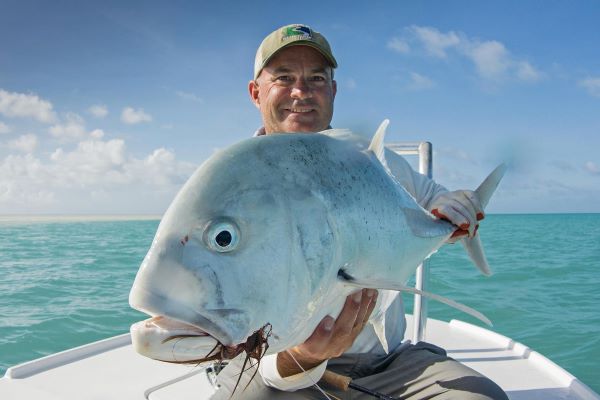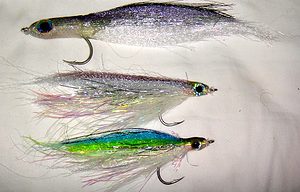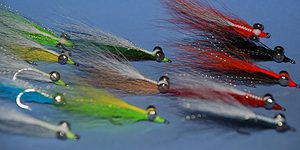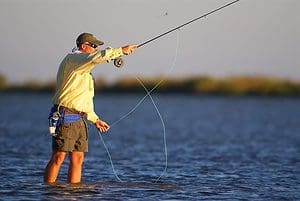Disclosure: Some posts contain affiliate links, which earn us a commission if you make a purchase through them. Positive Fishing © participates in various affiliate networks including the Amazon Services LLC Associates Program.
When fly fishing for Giant Trevally, your fly choice matters, and it matters more than the Insta-World might have you believe. GTs are super intelligent fish and you’re not going to fool them by throwing something that doesn’t look right.
I’m sure you have seen the Blue Planet II episode of GTs on the Seychelles island of Farquhar that was actually eating birds. It’s phenomenal footage and goes to show that these fish are ultimate predators that can track their prey through the air, and they will do the same with your fly.
Knowing which fly to use in different circumstances and how to fish them properly is going to make all the difference when you’re trying to catch one of these awesome fish.
In this article, I will share with you my personal fly choices that will give you the best opportunity to catch a Giant Trevally.
I have put these as the must-have five flies given my extensive experience as a fishing fly guide in Seychelles and other flats hotspots around the world.
What Do GTs Eat?
The honest answer is, GTs eat absolutely anything they can get their hands on from small bonito to large crabs and even birds as mentioned above.
Now, we are not going to suggest throwing a big bird dry fly to a GT, although it might be fun, let’s focus on what they eat most, small baitfish, squid, and crabs. All the most effective GT flies imitate small fish or squid which range from 3 – 5 inches in length or resemble a large crab.
What Are The Must-Have GT Flies?

The best GT flies that you should have in your fly box when targeting these awesome fish are brush flies, semper flies, clouser minnows, double-barrelled poppers, and NYAP flies.
One key thing to remember is to always choose the best quality hooks, as these fish pull hard and can straighten poor-quality hooks easily during the fight. The best hooks are Gamakatsu 6/0 or 4/0s for these fish.
Brush Fly

A brush fly imitates both a small baitfish and a squid and it gets its name from the manner in which it is tied. Fly tiers will make a “brush” to form the body of the fly and create an amazing profile that many saltwater species are attracted to.
A brush fly is tied mainly using synthetic materials which makes it both light to cast with and durable enough to catch 3 or 4 fish before it’s done. The toughness of the synthetic material also lets tiers add large realistic eyes to the fly making it very appealing to GTs.
Size & Colors
The best size brush flies for GTs is a 6/0 or 4/0 as these are large enough to get the fish’s attention but still light enough to cast a reasonable distance with.
Being made of synthetic materials means brush flies can come in a large range of colorful options and you’re always going to want a few different colors to choose from. Here are the best brush fly color combinations to have in your collection:
- Tan
- Tan & White (my favorite on the sand)
- Chartreuse & White
- Blue & White
- Black
- Black & Purple (my favorite for the surf)
- Black & Red
- Olive
- Red
- Red & Yellow (an all-time favorite known as the Flaming Lamborghini)
How To Fish A Brush Fly?
Cast the fly 2-3 rod lengths in front of the fish and strip in any slack. Let the fly sink until the fish is 6-10 feet away from it and do a long slow smooth strip. Continue stripping while matching the GT for pace, stripping faster if the fish accelerates or keeping a slow strip if the fish is following slowly.
Semper
The Semper is a great GT fly as it is tied with natural materials that give it excellent action in the water. The tail of the fly is tied using Schlappen (chicken feathers) which gives the fly a natural movement and the body is made from a palmered marabou.
A Semper will imitate both a baitfish and a squid and is an excellent fly that will get a there attention without a doubt.
Sizes & Colors
Like a brush fly, the best size for a Semper fly is 4/0 or 6/0, and having quite a few color combinations is necessary too. Here are the best color combinations for a Semper that you should have in your fly box.
- Tan & White
- Chartreuse & White
- Black & Purple
- Olive & Red
How To Fish A Semper fly?
You should fish a Semper fly the exact same way as you should fish a brush fly as they imitate the same things. The one difference between the two flies is their sink rates as sempers will sink a little bit faster being made from natural materials.
Clouser Minnow

The Clouser minnow is another excellent GT fly and an all-around great fly when fishing for any predatory fish.
The reason the Clouser minnow is so effective is due to it having weighted dumbbell eyes which give it a particular action as it will move up and down through the water column as you strip it. The hook also sits upwards making snagging the bottom a lot less likely.
The one downside to these flies is that the extra weight makes them harder to cast, so be sure you can handle them and watch out as they hurt a lot when they hit you or your guide (by mistake of course).
Size & Colors
Again, the best size closure minnow for GTs is a 6/0 or a 4/0, and the most effective versions are tied sparsely with very little flash and in the color combinations below.
- Tan & White
- Blue & White
- Chartreuse & White
- Grey & White
How To Fish A Clouser Minnow?
Since Clouser minnows sink you can also use them as a searching pattern in deeper areas on a sinking line. In this case, you would want a heavier-weighted fly. Light versions are great for the flats and should be fished just like a brush fly but don’t wait for it to sink too long to avoid being snagged on the bottom.
Double-Barrel Popper
The double-barrel popper is another great fly for GTs and it’s very different from the other flies featured above as it is a surface fly. The fly is tied using a foam head and synthetic or natural material as the tail.
When fished correctly, the double-barrel popper makes a huge amount of surface noise and a large bubble trail that the fish can hear and are attracted to. It’s an excellent fly for both shallow water sight fishing and blind casting in deep areas too.
Size & Colors
Unlike the other flies featured, this fly is best off tied on a size 8/0 hook as the larger gape helps with your chance of hooking a GT when it eats on the surface. You probably only need about four of these flies in your fly box and the colors should be as follows:
- White head & tan/white tail
- White head & chartreuse tail
- Black head & purple tail
- Black head & red tail
How To Fish A Double Barrel Popper?
These flies are harder to cast when it’s windy as the foam head gets blown around a lot. You should cast the fly as far as you can and then retrieve it with long hand strips to create a large noise and bubble trail through the action.
Make sure you pause for 2-3 seconds between each strip to give the fish time to hear all the commotion.
NYAP
Another surface fly that is great for these fish is the NYAP (Not Your Average Popper). This fly was created by James Christmas, a guide on Alphonse Island in Seychelles. It’s tied using a foam head and natural or synthetic materials for the tail.
It’s easier to cast than a double-barrel popper thanks to the lighter head and slimmer profile and it does a great job of attracting the attention of GTs. The action, however, is dependent on how well it’s tied as a badly tied NYAP can swim sideways or not at all.
Size & Colors
The right size for a NYAP is either 6/0 or 8/0 and you should have this range of colors in your box.
- White head & tan/white tail
- White head & chartreuse tail
- Black head & purple tail
- Black head & red tail
How To Fish A NYAP
You should fish a NYAP the exact same way as a double-barrel popper when blind casting or the exact same way as a brush fly when sight fishing in shallow water.
What Are The Best Hooks For Fishing For GT?
Without a doubt, the best hooks are the Gamakatsu 6/0 or 4/0s. Gamakatsu started making hooks in 1955. These high-carbon steel hooks are renowned by the best saltwater anglers for their high-quality standards.
Gamakatsu hooks are super strong but not brittle like some other hooks. Fishing for travellies requires the best hooks given their ability to fight so hard and with such hard predator mouths.
3 Awesome Tips For Catching GTs

Now that you know exactly what to stock your fly box with for catching GTs, here are a few tips to help you while you’re out on the water.
- Practice casting your 12-weight fly rod for a month before your trip. Casting a 12-weight isn’t easy and you will need to deliver accurate casts up to 60-70 feet into the wind in some cases
- Stay calm and listen to your guide. Casting to a GT is about as exciting as fly fishing gets but staying cool at the moment is incredibly hard. Stay calm, deep breaths, and follow your guide’s instructions
- Never lift your rod. If you lift your rod when setting the hook and even while fighting a GT, chances are you’re going to lose it. – Leave the trout set at home
Winding Up
Thanks very much for reading my article. I hope you enjoyed it and are now filling your fly box with the right flies for your next trip. GT’s are epic fish to catch on the fly, enjoy it!
If you want to learn more about becoming a professional fishing guide check out the link and also be sure to read my article on how to catch a Triggerfish on the fly.
- Top Tips For Fishing With Feathers - January 15, 2025
- How To Fish For Flounders: Tips, Rigs, & Baits - March 27, 2024
- Fortis Wraps Fishing Sunglasses: The Affordable Option For Anglers - January 25, 2024

